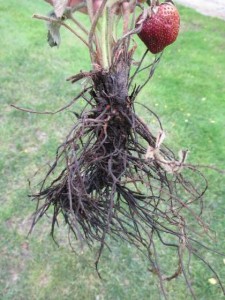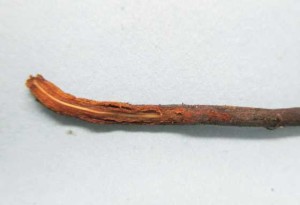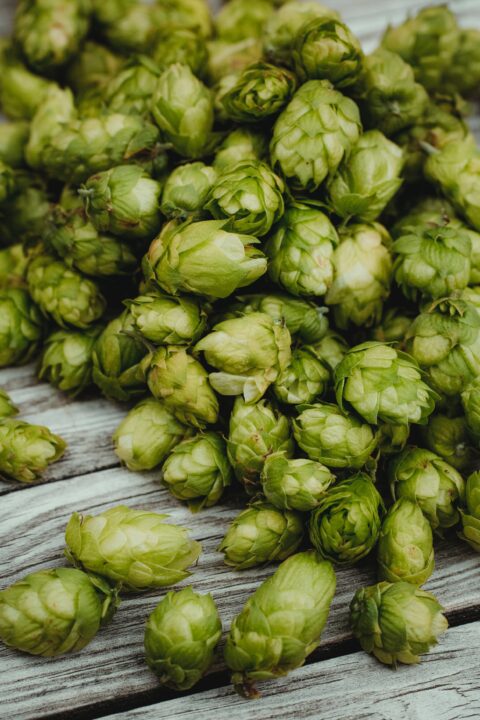Manage Black Root Rot Of Strawberry
Black root rot of strawberry is a disease complex caused by multiple pathogens that enter strawberry roots through feeding wounds from nematodes or as a result of environmental stresses. Lesion nematodes, or Pratylenchus penetrans, are most commonly associated with black root rot, and the most common fungi associated with the disease are Rhizoctonia fragariae, various species of Pythium, and Fusarium.

This strawberry plant with black root rot has virtually no healthy roots left. Photo credit: Annemiek Schilder
According to Annemiek Schilder, associate professor in the Department of Plant, Soil and Microbial Sciences at Michigan State University, nematodes cause damage by feeding on the plant roots, which then allows the fungi to enter.
Black Root Rot Symptoms
Schilder explains that black root rot builds up in strawberries over time, and growers are not likely to detect it in their fields until the second or third year of the planting.
“The plants will look fine the first year or so, but as they age, the disease builds up and they start to look worse and worse. Sometimes people have to plow under the field after two bearing years,” she says.
After the disease has been present in the plants for at least a year, growers will start to notice plant stunting, low yields, reduced vigor, and small fruit.
“In the worst situations, you might see a 50% yield reduction. Under conditions of drought, stress — or especially getting close to harvest — you’ll see plants dying back in patches in the field. You might have poor-looking or bare patches,” Schilder explains.
However, the real symptoms of the disease are seen in the roots, so growers will have to dig up the plants to properly identify the culprit.
If black root rot is present, there will be a considerably reduced number of fine roots, leaving only the thicker main roots, a symptom also known as rat tail. The roots that are left will be black, or if the plants are younger, covered in brown lesions. When the roots are cut open, you’ll notice that the center, otherwise known as the stele, will be creamy white. Schilder mentions that it’s important to distinguish these symptoms from another strawberry root disease — red stele, caused by Phytophthoera fragariae — because the two are often confused. With red stele growers will see that the outside of the root is lighter and the inside is reddish-brown in color.

In infected plants, when the root is cut open, the stele is still light-colored while the rest of the root is brown to black. Photo credit: Annemiek Schilder
“In many cases, people will see the symptoms and say, ‘Oh, we have red stele’ but red stele is a disease more commonly found on heavier soils, like loam or clay soils, with poor drainage. And you see some of the same symptoms, but plants with red stele go down very quickly,” she explains.
Proper Scouting
Schilder says that infection can take place at any point from the nursery to the field. Before planting, she advises growers to check to make sure the transplant roots are healthy, and creamy-white in color.
“[You shouldn’t] see a lot of black roots or browning in the transplants already — aside from plants that may have had problems during storage or transportation. Make sure the plants look healthy before planting,” she says.
Biochemical And Chemical Controls
What products can be used to control black root rot? Schilder suggests the biological fungicide Rootshield (Bioworks) which you can apply directly to the roots, as well as Cease, a microbial bactericide/fungicide, from the same company.
She’s also evaluated the fungicides Abound (Keystone Pest Solutions), and Prophyt (Helena Chemical Company).
“We found that with Abound — labeled against Rhizoctonia and Fusarium — even in a situation where we had nematodes, we were able to suppress the fungi enough to get that boost in plant growth and yield the following year,” she says.
6 Cultural Controls To Follow
Schilder mentions key cultural control measures to help reduce the incidence of black root rot in strawberries.
- Prevent environmental stress. For example, lay down straw in the winter to protect plants from cold injury and make sure there is good drainage. This will help ensure that conditions are right for plant establishment.
- Rotate out of strawberries. “Do at least two to three years out of strawberries,” she suggests. “I know some people that have more land will do maybe three to five years; that would be preferable.”
- Use nematode-suppressive rotation crops. Use rotation crops such as sweet corn, pumpkin, cole crops, and rye, which are poor hosts of lesion nematodes. “With those crop rotations we had the lowest nematode populations,” she says. She warns against using legumes as rotation crops, however, because they tend to be susceptible to lesion nematodes, which play an important role in black root rot. If legumes are used for nitrogen-fixation, they should be used earlier in the rotation, not right before strawberries.
- Use resistant or tolerant varieties. Schilder mentions a few varieties out of Nova Scotia, Canada that she’s seen work well, for example, Kent, Cavendish, and Cabot (all three developed by Agriculture and Agri-Food Canada). “We found that they will make enough new roots to survive. They still get the disease, but because they are so vigorous they don’t seem to be affected as much, and they do pretty well under those conditions,” she explains.
- Do a nematode analysis before planting. This will help determine if you have a high-risk situation, Schilder says. If there is a high number of nematodes in the soil, especially if you’re in a sandy site where they may have built up from a previous crop, you may want to consider fumigation, or planting another crop instead.
- Start with healthy plants. Make sure you buy your plants from a reputable nursery. Cheaper is not always better, Schilder warns.









